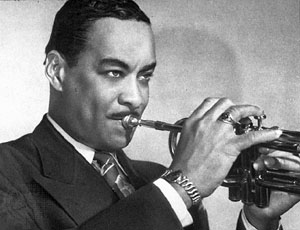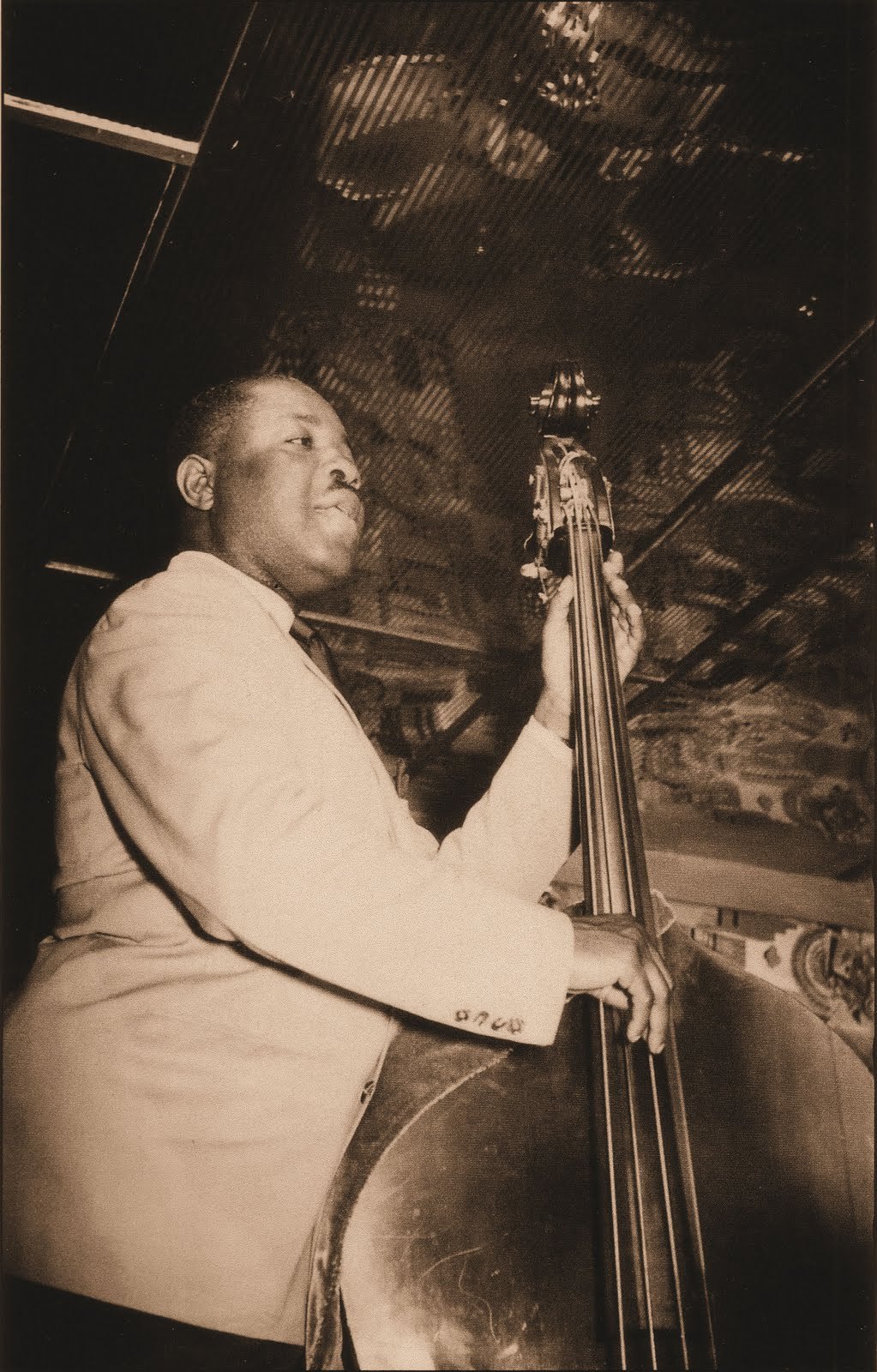
Trumpet player Buck Clayton hooked up with Count Basie's band in late 1936 after dropping in on them in the Reno Club in Kansas City. However he had enjoyed a lot of success prior to joining the orchestra at this time. A native of Kansas he had toured around the south in the late 1920's getting into various scrapes with the locals before heading out to California in in the early 1930's. It was here that he had a chance encounter with Louis Armstrong. Clayton endeavoured to study Armstrong's technique after seeing him play at Frank Sebastian's Cotton Club.
At this time Clayton was to make a remarkable career move by moving to Shanghai. He ended up staying there for two years playing at the luxurious Canidrome for high society types including Chiang Kai-shek's wife who was a regular at the club.
Success with the Basie band lasted right through to 1943 when he was inducted into the army. During this time Clayton recorded on many of the big hits including One O'Clock Jump. He was also heavily involved in the celebrated recordings in 1937 with Billie Holiday and Lester Young, played at the Benny Goodman show at Carnegie Hall and the From Spirituals To Swing shows in New York.
In the mid 40's he managed to make some recordings with the rising star of jazz at that time, Charlie Parker. Clayton more than held his own. He went on to become a leading figure in the mainstream jazz scene of the 1950´s when he recorded and gigged prolifically.
Check out Clayton jamming with Dexter Gordon and Charlie Parker on the track Takin' Off
Jo Jones

Jo Jones' name has cropped up quite recently due to the massive success of the film "Whiplash". In it one of the main protagonists tells the story of how a young Charlie Parker had a cymbal thrown at him during a jam session by Jones for simply not being up to scratch. Parker subsequently began a period of obsessive practicing before appearing on stage again. While this apocryphal tale suited the narrative of the bullying teacher for the film it never quite happened like that. Jones however did "gong" Parker, an act of throwing down the cymbal at someone's feet. Ultimately they were jazz worlds apart. Jones, one of the main proponents of the "All-American Rhythm" that propelled the Count Basie band and Parker, who would steer away from the notes on the page to establish bebop as the driving force of jazz in the 1940s.
Jones was pretty much one of the inventors of swing jazz drumming, up there with Chick Webb and Gene Krupa in establishing the instrument as the backbone of any jazz orchestra. The four-four glide on the ride cymbal that is the pulse of swing jazz was invented by these guys. They were true innovators in that the instrument that they played did not physically exist 10 years before. Jones was to differ from Krupa's bombastic bass notes and would often omit the bass drum in favour of a ride rhythm on the high hat while it was continuously opening and closing.
Jones was to earn his stripes playing with the Walter Page's Blue Devils in the late 1920's. He was present for Basie's very first recordings in 1936 and stayed with the band until 1948. He was an ever present in a plethora of recordings in the 1950's due to his association with Norman Granz's Verve label. A true artist on the drums.
Herschel Evans

Count Basie employed two tenor saxophonists. In one corner was Lester Young whose sound would be emulated by all and sundry in the following decades. In the other corner was Herschel Evans one of the earliest "tough Texas tenors" whose sound and style could not be more different. Yet the two complimented each other superbly and brought a freshness and verve to the early Basie recordings.
Tragically Evans' career was all too brief. He died in 1939 at the young age of 29. As with some of his contemporaries we can only wonder at the direction his musical career would have taken.
Jimmy Rushing
.jpg)
John Hammond introduced him to stage with tongue firmly in cheek as "Little" Jimmy Rushing in Newport in 1957. His actual nickname was Big 'Un
Count Basie needed a blues shouter to augment the big sound emanating from his orchestra. The man who provided that sound was Jimmy Rushing who was in the band from the beginning right through to 1948. As with many others he cut his teeth with The Blue Devils and later with Bennie Moten's band in the late 20's/early 30's. Songs like Pennies From Heaven, Boogie Woogie and Sent For You Yesterday exemplify Rushing's sound on the early Basie records.
For me his influence lay in the fact that he was unique. Taking his jazz queue from the vocals of Louis Armstrong he brought a powerful subtlety to the songs that he sang. You couldn't label him as a blues shouter (indeed he considered himself a ballad singer.) He could probably sing anything such were his vocal talents.
Freddie Greene

The guitar as a solo instrument really began to blossom in the mid 1930's with the advent of amplification and the Gibson ES-150 model becoming popular among jazz musicians post 1936. It was the era of Django Reinhardt and Charlie Christian who tried to emulate the saxophone and trumpet solos that dominated jazz music up to that time. So it is perhaps all the more remarkable that one of the most popular guitarists of the era was Freddie Greene. He never opted for a solo. His raison d'etre was to augment the rhythm of the band, hence his place firmly among the All-American rhythm section of the Basie orchestra was established from the time he joined in 1937. He was even to say that "You should never hear the guitar by itself. It should be part of the drums so it sounds like the drummer is playing chords—like the snare is in A or the hi-hat in D minor".
He remained with the Basie band for over 50 years.
Here's a 1962 called The Elder. It has all the ingredients; Basie piano, walking bass, riffs, bombastic drums and wailing trumpet. But check out a beautifully rare Green rhythm solo halfway through.
Walter Page

The final piece of the All-American Rhythm jigsaw. Page had established himself well enough in the 1920's that he was the boss of one of the most innovate bands of the time, The Blue Devils. The band consisted of at one time or another Jimmy Rushing, Count Basie, Hot Lips Page and later Lester Young. After Bennie Moten lured Count Basie to his band the writing was on the wall for Page as a band leader. He eventually joined Moten's Kansas City Orchestra which went on to become Basie's big band after Moten passed away in the mid 30's.
Page will forever be associated with the incredible chemistry that he developed with Jo Jones and Freddie Greene, especially on those early Basie tunes. He is also credited with inventing or at least innovating the "walking" bass style that would become synonymous with swing jazz in the late 30's. Along with Wellman Braud and later Jimmy Blanton he was one of the key figures in establishing the bass as harmonic as well as a rhythmic instrument.
Check him out on Pagin' The Devil a song that he recorded with the Kansas City Six in 1938. The musicians on this track include Lester Young, Eddie Durham, Freddie Greene, Jo Jones and Buck Clayton.






